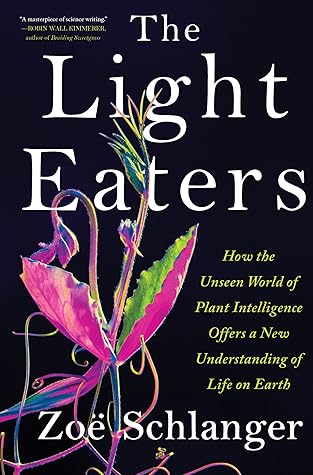More on this book
Community
Kindle Notes & Highlights
Read between
December 9 - December 19, 2024
Still, I regarded its stump with admiration on my way out of the house every morning. It was already sprouting new green protrusions. You have to respect a good hustle.
They make food out of light and grow rooted to one spot, spending decades or centuries probing their environments for sustenance.
I awoke in the mornings at dawn because I’d recently noticed that this was when the world was most alive. How had I ever not known?
What is a plant without a means to communicate? A husk.
The world is a prism, not a window. Wherever we look, we find new refractions.
Glutamate is the most important neurotransmitter in our own brains, and research has recently found that it plays a role in plant signaling too, boosting the signal.
“If biology has something that works well, it pops up in lots of different organisms looking very similar, because why reinvent the wheel when you already have the wheel?”
the tomato plant will inject something into its leaves that makes the caterpillars look up from their chewing and turn to eye their fellow caterpillars. Soon, the leaf becomes irrelevant. The caterpillars begin to eat each other.
It has long been known that plants emit very quiet clicking noises when air bubbles in their stems pop as water travels up them. This process is called cavitation, and these “cavitation clicks” seem to increase when plants are dealing with drought stress.
Once coiling is complete, the dodder sprouts rows of vampiric spikes along its coil edges. The spikes sink into the host’s flesh and begin to siphon off its juices.
It is a foregone conclusion that plants produce far more complex compounds than our instruments can sense.
Semiochemicals are any compound that is synthesized in one body and released to infiltrate another.
After all, the orchid is reproducing through sex with a wasp.
“Nobody cares if you chop up plants,” she said; “they call that making dinner.”
British biologist J. B. S. Haldane was rumored to have declared, “I would lay down my life for two brothers or eight cousins.”
As almost always, radical new ideas in science are met with extra helpings of doubt.
Plants remind us that we are contiguous with our environment, impacted by its every fluctuation, impacts that reverberate through our lineage.
My blood cells that course through my veins like water through rootlets are each kept ruby red with the oxygen plants made. The branching structure of my lungs are suffused with that too. Every inward breath of mine was first breathed out by plants.
An encounter with a plant is an encounter between two beings.
Seeing plants as beings worthy of rights would open up a different realm of being with plants. It would revolutionize our moral system, our legal system, and the way we live on this earth.
After all, who we are shows itself not just in the outcomes of our goals but in the paths we take to get there. The trying says more about what is inside us than does the success.


